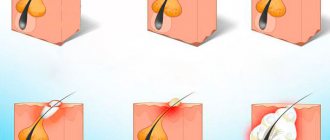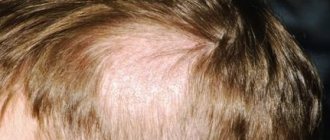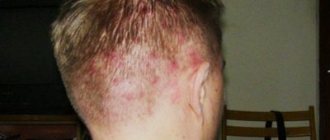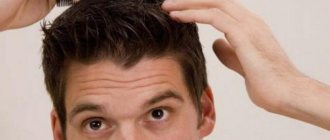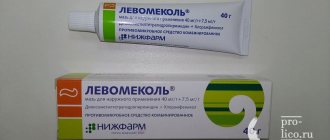Quick navigation
- Why do pustules and pimples appear on the head?
- The main causes of acne on the head
- We solve emerging problems step by step
- What is important to consider during treatment?
- Or maybe these are not just pustules?
Unfortunately, even girls who carefully monitor their appearance and the condition of their body experience such an unpleasant situation as ulcers on their heads in their hair. Treatment for this problem may vary depending on what caused the problem in the first place. It is necessary to understand what such a manifestation indicates. Perhaps you should worry about your overall health, and not just about the appearance of acne on your head? Let's look at what such an unpleasant factor will be associated with.
Why do pustules and pimples appear on the head?
We recommend reading: Hair restoration after dyeing, what to do?
Many people know from school biology courses that the skin has three layers. These are the epidermis, dermis and hypodermis. The sebaceous glands, which are located in the middle layer of the skin, together with other glands, produce secretions that come to the surface of the skin. Thanks to this, a special film appears, protecting the covers from damage. It guarantees hydration and minimizes the likelihood of penetration of harmful bacteria. If there is a hole in such a protective “suit,” bacteria penetrate under the skin and inflammation appears. In most cases, this is possible when the sebaceous glands of the skin work very hard. Most often this occurs during adolescence.
If we talk about red pimples that appear on the head, they appear no matter how old a person is.
In young children, purulent pimples can be an indicator of an allergy to some food.
Symptoms of bumps with pus in the hair
The initial stage of damage to the hair on the head with the formation of an abscess begins when a bacterium penetrates into healthy tissue and a dense inflammatory infiltrate is formed. The development of a pimple is accompanied by redness around it, and a white covering forms on the surface of the abscess.
Need advice from an experienced doctor?
Get a doctor's consultation online. Ask your question right now.
Ask a free question
At the initial stage, the size of the abscess does not exceed 0.6-10 mm, the shape is regular round. With the progression of the pathology, the focus of suppuration in the hair grows, changing its outline, and clinical symptoms appear:
- pain, which intensifies with pressure, can radiate to the neck, jaw, and facial area;
- itching, worse at night;
- after wearing a headdress, you may experience a feeling of discomfort and tightness of the skin on your head;
- local hyperemia;
- increase in general body temperature;
- deterioration of the condition with the development of weakness, drowsiness or irritability, nervousness;
- headache;
- sensory organ disorders – hearing impairment, visual disturbances.
If characteristic symptoms appear, you must consult a doctor to diagnose the condition and prescribe treatment.
It is dangerous to self-medicate due to the risk of complications of ulcers on the scalp.
The main causes of acne on the head
- Uncontrolled use of various medications, ointments, creams.
- Genetic or individual predisposition to excessively intense work of the sebaceous glands of the skin of a certain person.
- Constant use of caps, hats and other headwear made from synthetic fabrics. Such material will lead to increased sweating.
- Problems with metabolism or hormones in the body. Their excessive production is observed.
- Seasonality, risk of temperature changes, increased dryness or humidity.
- Manifestation of stress, nervous overexcitation, life in constant fear.
- Incorrect selection of hair care products or care that is carried out very rarely.
- Smoking, alcohol, unhealthy diet.
- Problems with the gastrointestinal tract or other organs.
From the above it is clear that there can be quite a lot of factors influencing the occurrence of such reasons. Which option is present in each individual case will be determined only by the doctor. This is where we will begin to consider how to treat rashes.
We recommend reading: Molecular hair restoration, reviews and prices
Features of child treatment
In children, boils appear on the head under the hair quite often due to poor hygiene and hypothermia. Small ulcers on the head are not dangerous; they go away with minimal treatment. However, the child needs to be explained that he should not touch the inflamed area. If boils appear in several places on the scalp, you should immediately consult a specialist for treatment.
A feature of the course of furunculosis in children is frequent relapses. The children's immune system is not able to maintain the production of protective immunoglobulins for a long time. When pathogenic microbes enter the skin layers again, the skin’s own defense does not work and inflammation develops again. Another feature is that children's skin is thin and easily vulnerable.
We solve emerging problems step by step
Firstly, only a doctor can give you an accurate diagnosis. Secondly, remember that such manifestations are isolated, and in this case you can cope with them at home without any problems.
So what needs to be done?
It is important to analyze the causes of the disease.
How to do it?
- Try to track what foods you eat daily. Minimize the presence of smoked and salted foods, chocolate, coffee and alcohol in your diet. Usually they influence the increase in secretion production by the sebaceous glands, which will clog the scalp. If you carry out the correct calculations and actions, the functioning of the stomach will normalize. Afterwards there will be less stress on the skin, but you can supplement this care for your body with vitamins and minerals, which will bring considerable benefits.
- The second option is to focus on the products you use to care for your scalp. It is possible that you selected the wrong shampoo and conditioner based on your hair type. Problems often occur when the frequency of washing your hair is incorrectly chosen. Perhaps you need to wash your hair less often than you usually do. By cleansing your hair with shampoo every day, you will dry out the skin, resulting in the release of excess sebum. Experts also do not recommend washing your hair very rarely, because - this causes clogging of pores, which causes the proliferation of harmful microbes.
The existing problem needs to be solved.
How to do it?
- In those places on the head where there are visible manifestations and pustular pimples, it is necessary to cleanse using tar soap. It is available in many pharmacies. The product will help cleanse the skin, improve its condition, and will not cause irritation or rashes.
- It is possible to use salicylic alcohol. This is an excellent antiseptic that gives noticeable results. But do an allergy test before use. Application will occur locally - only to the place where there is a problem.
- If there are large enough pustules, you can purchase a special antibacterial ointment at the pharmacy. It is advisable to do this after consultation with a dermatologist. Use products on a clean scalp after you have washed your hair. An alternative option is to create a bandage overnight. Some people use the most common ichthyol to solve the problem.
- Taking baths containing sulfur. This is a fairly well-known method, but it is quite difficult to do it at home. On the other hand, you can use drugs that contain sulfur. Please note that it is not a natural component that is used here, but its synthetic analogues. Naturally, in some cases the effectiveness of this method will be minimal.
Why is pathology dangerous?
Any purulent-inflammatory process can lead to the spread of infection throughout the body. Furunculosis on the head is more dangerous due to its close location to the brain. If the infection penetrates the blood-brain barrier, the sensitive membranes of the brain quickly become infected and meningitis and encephalitis are formed. With the development of these complications, the prognosis for the patient is unfavorable, even death.
A small boil on the head, if not aggravated, should quickly ripen, and after 4-5 days the tissue is completely regenerated, not even a trace remains at the site of the boil.
If the patient injures the affected area, the infection spreads to adjacent healthy tissue. Inflammation of the sebaceous glands begins, neighboring hair follicles become infected, and several abscesses form. This process will require long and careful treatment.
Another dangerous complication if proper treatment is not followed is sepsis, that is, blood poisoning. In a healthy person, the blood is sterile and does not contain any bacteria. With extensive infection or mechanical damage to the boil, pathogenic bacteria enter the interstitial fluid and then into the bloodstream. Blood has a bactericidal effect, but with a large number of bacteria and a decrease in immune functions, the infectious agent does not die, but is spread through the bloodstream throughout the body. Staphylococcus or other microbes begin to infect new areas of the body, take root on the mucous membrane of the intestines and other organs, provoking endless foci of inflammation. This serious complication requires urgent hospitalization. Treatment with loading doses of antibiotics cannot always stop sepsis; the prognosis for the patient is rarely favorable.
What is important to consider during treatment?
We recommend reading: Indian hair cosmetics, what you need to know
If pustules begin to appear on the scalp, then under no circumstances should you squeeze them out. Due to damage to the skin, you can introduce more infections into the wound. If there are too many such manifestations, then they can indicate quite serious problems in the body. Even infection by a virus is possible. Trying to squeeze out pimples will only make the situation worse and treatment will become more difficult.
Maximum attention must be paid at the moment when you wash your scalp. This must be done so gently and delicately so as not to scratch or damage the existing pustules. It is even more important to dry your hair carefully.
Folk remedies and treatment in this case are also relevant. You can use infusions of medicinal herbs such as calendula, yarrow, and celandine. Most often, hair is rinsed with the product after it has been washed.
If simple remedies do not help, and the situation does not improve, but only worsens, then it is still advisable to visit a dermatologist.
Causes of boils
The cause of boils is infection of the hair follicle with Staphylococcus aureus bacteria (most often) or other pathogenic microorganisms. An infection can get into the hair root when scratching the head with dirty hands. Any cracks, scratches, or burned surface are suitable conditions for the penetration of pathogenic flora into the dermis.
A boil appears on the head suddenly, without previous general symptoms. According to statistics, there is a surge in furunculosis in the head and neck area in the autumn and spring periods. This seasonality is explained by provoking external conditions - drafts, wind, increased humidity - and a decrease in one’s own defenses due to hypovitaminosis and deterioration of immunity.
After infection of the hair follicle on the head, an inflammatory reaction begins in nearby tissues. In place of the hair, a purulent rod forms. This process is caused by a defense response when macrophages are released to fight infection. Dead leukocytes and bacteria form purulent masses. With significant suppuration of the boil, tissue at the site of inflammation may partially die. This process is called necrosis.
Or maybe these are not just pustules?
Remember that the appearance of pustules on the scalp does not always indicate problems with hygiene or excessive work of the sebaceous glands. It happens that there are some diseases in the body that do not manifest themselves in any other way. However, the doctor will be able to find out what exactly the problem is and help solve it. This way you will not only get a healthy scalp, but also prevent various diseases, which in the active stage during treatment can entail large expenses, as well as deterioration of health. Be careful and monitor your well-being, do not refuse to visit a doctor if necessary.
Read: Lebel hair cosmetics. Effect of using products
Types of pyoderma
The disease is classified depending on the type of pathogen, as well as on the nature of the course. In the first case, streptoderma and staphyloderma are distinguished, in the second - acute and chronic pyoderma.
Staphyloderma is divided into:
- Superficial (ostiofolliculitis, superficial folliculitis, etc.).
- Deep (for example, carbuncle or deep folliculitis).
It is staphylococcal lesions that usually involve hair follicles and sweat glands. Streptoderma most often affects smooth skin. They can also be deep or superficial. In addition, a fungal component is often associated with the disease, which complicates its course.
Message sent!
What measures can stop the further appearance of boils?
To avoid relapses of furunculosis, it is necessary to strengthen the immune system. Hardening, taking vitamins, and proper nutrition with sufficient intake of proteins and microelements helps develop resistance to skin infections.
Autohemotherapy helps increase resistance to infections to which the body is susceptible. The principle of treatment is that several cubes of blood are taken from a vein and immediately injected intramuscularly.
If you follow hygiene standards, maintain the elasticity of the skin, eat only healthy foods, and do not overcool, then the risk of boils appearing is minimal.
